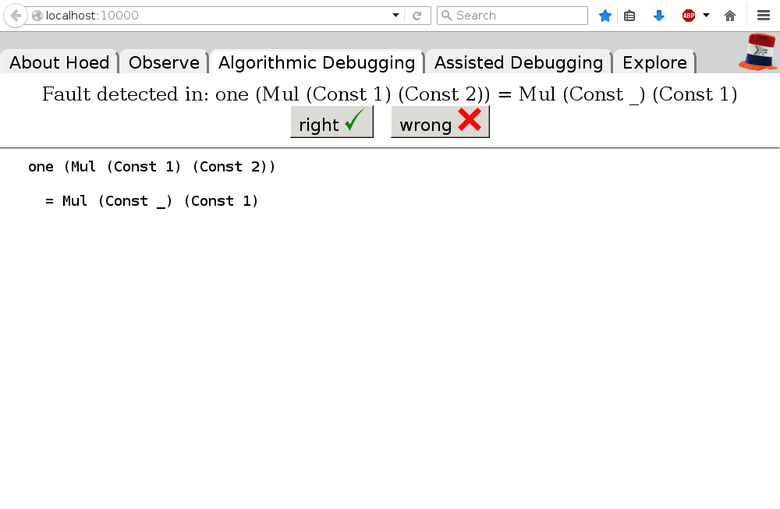Difference between revisions of "Hoed"
(view) |
(→Views) |
||
| Line 97: | Line 97: | ||
Hoed offers several views on the collected debugging information. |
Hoed offers several views on the collected debugging information. |
||
| + | |||
| + | Algorithmic debugging: |
||
| + | [[File:HoedAlgorithmicDebugging.png|780px]] |
||
== Comparison with Other Tracers and Debuggers == |
== Comparison with Other Tracers and Debuggers == |
||
Revision as of 11:10, 4 December 2015
Hoed is a lightweight tracer and algorithmic debugger that is practical to use for real-world programs.
Using Hoed
To locate a defect with Hoed you annotate suspected functions and compile as usual. Then you run your program, information about the annotated functions is collected. Finally you connect to a debugging session using a webbrowser.
Let us consider the following program, a defective implementation of a parity function with a test property.
isOdd :: Int -> Bool isOdd n = isEven (plusOne n) isEven :: Int -> Bool isEven n = mod2 n == 0 plusOne :: Int -> Int plusOne n = n + 1 mod2 :: Int -> Int mod2 n = div n 2 prop_isOdd :: Int -> Bool prop_isOdd x = isOdd (2*x+1)
Using the property-based test tool QuickCheck we find the counter example 1 for our property.
> quickCheck prop_isOdd *** Failed! Falsifiable (after 1 test): 1
Hoed can help us determine which function is defective. We annotate the functions isOdd, isEven, plusOne and mod2 as follows:
import Debug.Hoed.Pure isOdd :: Int -> Bool isOdd = observe "isOdd" isOdd' isOdd' n = isEven (plusOne n) isEven :: Int -> Bool isEven = observe "isEven" isEven' isEven' n = mod2 n == 0 plusOne :: Int -> Int plusOne = observe "plusOne" plusOne' plusOne' n = n + 1 mod2 :: Int -> Int mod2 = observe "mod2" mod2' mod2' n = div n 2 prop_isOdd :: Int -> Bool prop_isOdd x = isOdd (2*x+1)
Now we use the combinator testO to trace our program for the count-example of our property. After running the program a computation tree is constructed and displayed in a web browser.
> testO prop_isOdd 1 *** Failed! Falsifiable: 1 Listening on http://127.0.0.1:10000/
You can freely browse this tree to get a better understanding of your program. If your program misbehaves, you can judge the computation statements in the tree as 'right' or 'wrong' according to your intention. When enough statements are judged the debugger tells you the location of the fault in your code.
Annotating Functions
A function is annotated using an observe primitive with a String. An arbitrary value can be used, but we use the function name to have it in the trace for constructing the computation tree. For example the function
isOdd n = isEven (plusOne n)
can be annotated as follows
isOdd = observe "isOdd" isOdd' isOdd' n = isEven (plusOne n)
To observe a function its argument and result type need to be of typeclass Observable. Hoed comes with instances for the base types and several other commonly used types.
It is easy to make your own types Observable because Hoed also provides a type generic instance. For example
data Person = Person String Int deriving Generic instance Observable Person data Tree a = Node a [Tree a] | Leaf deriving Generic instance Observable a => Observable (Tree a)
Views
Hoed offers several views on the collected debugging information.
Comparison with Other Tracers and Debuggers
Hat is probably the most advanced tracer tool for Haskell. It traces every reduction and provides many tools for viewing this trace. Hat requires a transformation of every module, even libraries we are not interested in. The transformation does not support as many language features as GHC and in practice many programs cannot be debugged with Hat. In contrast, Hoed is just a library and only functions we are interested in need to be annotated. Many programs that are difficult to debug with Hat can be debugged with Hoed.
Most Haskell implementations come with a trace primitive that can be used for printf style debugging. However, the primitive can force evaluation. Consider for example applying the function headDoubler> to [1..] in
headDoubler xs = trace ("headDoubler " ++ show xs) (2 * head (xs) : tail xs)
main = print (take 3 (headDoubler [1..]))
HOOD can be used like Debug.Trace for printf-style debugging while respecting evaluation order. Observing headDoubler in above example gives headDoubler (1:2:3:_) = 2:2:3:_. Hoed is based on HOOD, but gives a relation between computation statements and adds an algorithmic debugger.
